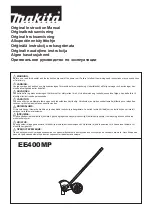
When the above text is displayed on the screen, put the electrode in the pH cell into the
pH 4 liquid supplied with the product and press the OK button.
PH electrodu, waits for 1 minute in pH 4 liquid and performs the same treatment for pH 7
liquid behind. If there is an imbalance in the section that says INITIAL PH, the product
automatically restarts the calibration.
The pH READ option allows the reading of the current pH value.
The language option allows you to change the menu language. Turkish language, English,
French, Spanish and Bulgarian languages are available.
Fault Message
This screen is displayed when the sensor detects no water and the control system stops
production. Check that there is water in the cell and that it goes to the top where the
probe is. Low levels can result from operating the chlorinator without the pump operating.
In this case turn off the device immediately.
THE CHLORINATOR SHOULD NEVER BE
CONNECTED IF THE PUMP IS NOT WORKING OR THE WATER IS NOT FLOWING FREELY.
THE POWER SUPPLY OF THE CHLORINATOR SHOULD DEPEND ON THE PUMP’S POWER
SUPPLY.
A low water level in the cell may also be due to a dirty filter, an obstructed circuit or
insufficient pump power. As soon as the water level is restored the fault disappears.
This screen appears when the salt concentration in the water is too low to
prevent cell damage. Add enough salt (5 or 6 kg / m3 ideally) and when it is
completely dissolved press any button to reset the device. This screen can also
appear if the water temperature is too low or if there is a bad connection in the
cell cable.
Manuel Cell Cleaning
GSC chlorinator is provided with a self-cleaning polarity change system that
almost eliminates maintenance work. But, when the calcium concentration is very high,
this characteristic may not be enough to completely eliminate the lime residue. Visually
inspect the cell regularly to detect the presence of lime and, clean the cell if it’s necessary.
Ideally, you should let the cell dry completely during one or more days for the lime residue
to release themselves. You can help this by slightly hitting the cell. In this process please
be careful that do not harm the electrodes delicate cover. Do not use any metallic or
stabbing element to scratch the electrodes. You could also use water pression.
If you are able to remove the lime residue in this way, please proceed with the
below instructions.
1-
Turn off the pump and the chlorinator
2-
Disconnect the DC cable for the cell, unscrew the thread and extract the cell
3-
If the pressurized water does not completely eliminate the calcium
deposits, submerge the cell in a 20% hydrochloric acid solution. Do not
submerge the cover of the cell where the terminals are. The hydrochloric
acid will react with the calcium producing gas.





























